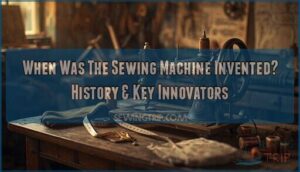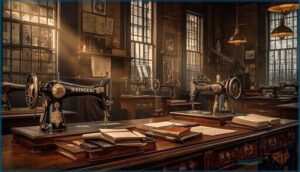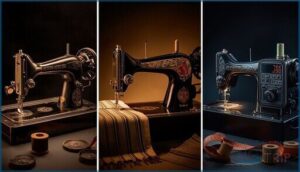This site is supported by our readers. We may earn a commission, at no cost to you, if you purchase through links.
You might think stitching fabric by hand defined garment-making for millennia, but mechanized sewing disrupted that reality faster than most industrial revolutions. The sewing machine wasn’t born in a single moment—Thomas Saint patented the first design in 1790, though his invention never left the drawing board. Barthélemy Thimonnier built the first working model in 1830, only to see French tailors destroy his factory out of fear for their livelihoods.
The real advance came in 1846 when Elias Howe perfected the lockstitch mechanism, followed by Isaac Singer’s commercialization efforts in 1851. These competing inventors didn’t just create tools—they ignited patent wars, transformed global manufacturing, and cut production time by 93%, reshaping how clothing reached your wardrobe.
Table Of Contents
Key Takeaways
- The sewing machine evolved through competing inventors across decades—Thomas Saint’s 1790 patent, Barthélemy Thimonnier’s 1830 factory model, Elias Howe’s 1846 lockstitch breakthrough, and Isaac Singer’s 1851 commercialization—culminating in patent wars and the 1856 industry alliance that legitimized shared licensing.
- Mechanized sewing slashed garment production time by 93%, accelerating from 30 hand-stitches per minute to 2,000 machine stitches, which destroyed the dominance of hand labor and unleashed factory-scale mass production that reshaped global textile manufacturing.
- Singer’s installment credit strategy and aggressive global expansion captured 80% of the market by the 1880s, transforming the company into one of the first multinational corporations while competitors like Wheeler & Wilson fought for market share through technical innovations like the rotary hook.
- The machine’s evolution continued through 20th-century electrification in the 1920s, zigzag stitching standardization by the 1930s, and computerized controls by 1978, with the global industry projected to reach $5.53 billion by 2030 driven by both industrial automation and home entrepreneurship.
When Was The Sewing Machine Invented?
You can’t pin down a single “eureka moment” for the sewing machine—its invention unfolded across decades, continents, and competing workshops. The story spans from 18th-century patent drawings to the lockstitch breakthroughs that finally made commercial success possible.
Here’s how the timeline breaks down, starting with the earliest attempts and ending with the designs that actually worked.
Key Dates in Sewing Machine History
You’ll find that the history of the sewing machine invention spans nearly a century of innovation. Early patents began with Thomas Saint’s 1790 design, followed by the lockstitch invention in 1846 by Elias Howe.
The timeline of sewing machine inventions accelerated with the Combination formation in 1856, then the zigzag stitch in 1873, and electric machines by 1905—each achievement revolutionizing how you create.
The earliest known patent was for a leather sewing machine designed by Thomas Saint.
Defining The First Successful Sewing Machine
Defining what counts as “successful” demands you look beyond mere patents to technical performance. The lockstitch importance became the technical baseline—Elias Howe’s 1846 innovation delivered durable seams that wouldn’t unravel, unlike earlier chainstitches. Commercial viability required production scale: by 1860, U.S. output topped 110,000 units. Patent enforcement validated winners. Isaac Merritt Singer’s improvements sealed mass adoption, but Howe’s lockstitch set the standard: Howe’s invention impacted the global garment industry.
- Durable two-thread interlocking stitch integrity
- Reliable continuous operation across fabric types
- Enforceable patents confirming novelty and utility
- Factory and household diffusion demonstrating market acceptance
Early Patents and Prototypes
Behind every successful machine lies a trail of forgotten experiments. Saints Design from 1790 sketched leather-stitching concepts, but Thimonniers Chainstitch actually worked—200 stitches per minute by 1830. Hunts Lockstitch prototype emerged around 1835, yet you’ll find Howes Patent (1846) claimed the enforceable lockstitch advancement.
Early Sewing Machine Inventors battled priority; by 1856, the Patent Pool ended their wars, legitimizing the Invention of the Sewing Machine through shared licensing.
Pioneers of Sewing Machine Innovation
The sewing machine didn’t spring from a single inventor’s workshop—it emerged through decades of bold experimentation and fierce competition. You’ll find that each pioneer brought a distinct advancement, from early patents that sparked the revolution to commercial designs that conquered global markets.
Here’s how four key innovators transformed a simple idea into an industrial powerhouse.
Thomas Saint and The 1790 Patent
Before anyone else saw the potential, Thomas Saint shattered convention with British patent No. 1764 in 1790—a complete sewing machine design buried under “glue, bookbinding” for nearly a century.
His invention targeted leather applications using chain stitch limitations that later innovators would overcome.
Wilson’s reconstruction in 1874 proved the mechanism worked, cementing Saint’s historical significance among early sewing machine inventors who dared to reshape production itself.
Barthélemy Thimonnier’s 1830 Machine
In 1830, Barthélemy Thimonnier broke new ground with French patent no. 7454, deploying a chain-stitch mechanism that finally moved from prototype to production. You’re witnessing early sewing machine history rewritten:
- First factory: 80 machines stitched army uniforms in Paris
- Tailors riot: 200 workers destroyed the operation in 1831
- Technical characteristics: Barbed needle, manual feed, wooden frame
- Later patents: 1841, 1845, 1847 refinements
- Legacy: Production-scale precedent despite commercial failure
Elias Howe and The Lockstitch Revolution
On September 10, 1846, Elias Howe Jr. secured U.S. Patent No. 4,750, unleashing the lockstitch design that forever changed textile production. You’re looking at an eye-pointed needle working with a shuttle to create a secure, interlocking stitch—250 stitches per minute against hand sewers’ slow pace.
By 1854, Howe’s patent litigation triumphed, commanding $5 royalties per machine and transforming technical significance into commercialization gold.
Isaac Singer’s Improvements and Commercialization
When Isaac Merritt Singer received U.S. Patent No. 8,294 on August 12, 1851, you witnessed sewing machine design transform through a foot-powered treadle and friction-pad tension control. The Singer Sewing Machine Company conquered patent conflicts by joining the 1856 pool, then unleashed mass marketing through installment payments—dollar down, dollar a week.
By 1860, global exhibitions and installment credit propelled unparalleled sales growth worldwide.
How Sewing Machines Changed The Textile Industry
The sewing machine didn’t just speed up stitching—it shattered the old world of handmade textiles and rebuilt an entire industry from the ground up. What once took hours by hand now happened in minutes, and that shift unleashed a wave of change across factories, fashion houses, and everyday wardrobes.
Here’s how this machine turned textile production on its head.
Transition From Hand Sewing to Machine Sewing
Hand sewing averaged 30 stitches per minute—you’d spend 12 hours making one shirt. Elias Howe’s 1846 lockstitch patent shattered that ceiling: machines delivered 2,000 stitches per minute, cutting production to just one hour.
This wasn’t mere invention; it was liberation through mechanization. Productivity gains forced labor reallocation as workers raced to adopt the technology, while cost reduction and rising quality standards accelerated technology diffusion across workshops, forever ending hand sewing’s dominance.
The sewing machine wasn’t just faster—it shattered hand sewing’s reign and forced an entire labor force to mechanize or perish
Impact on Mass Production and Garment Factories
By 1860, machine stitching slashed shirt production from 14 hours to one—a 93% time saving that unleashed factory-scale expansion. You witnessed:
- Factory productivity soaring as Singer’s output jumped from 810 machines (1853) to 262,316 by 1876
- Labor organization shifting into sweatshops and mechanized lines
- Supply chains aligning thread mills with industrial sewing machines
- Ready-made clothing exploding as mass production redefined the garment industry
Influence on Fashion and Clothing Availability
Fashion democratization accelerated after mechanized sewing slashed garment costs and time. Ready-to-wear growth surged from $40 million in 1850 to $70 million by 1870, while standardized sizing—born from Civil War measurements—enabled consistent fit across markets.
You gained consumer affordability as shirt labor costs plunged 96%. Textile transformation delivered more clothing sets per household, erasing geographic barriers through mail-order catalogs and making elite styles accessible to working families by 1913.
Major Sewing Machine Manufacturers and Milestones
Once inventors proved the sewing machine could work, the real battle began: who would dominate the market and reap the profits? The 1850s sparked fierce competition among manufacturers, leading to significant legal battles that reshaped patent law and business strategy.
You’ll see how Singer rose to global dominance, how rivals like Wheeler & Wilson fought for their share, and why these companies eventually formed an uneasy alliance to control the industry.
The Rise of Singer and Global Expansion
By the 1880s, you witnessed Singer capturing roughly 80% of the global market share—a dominance fueled by ground-breaking installment credit plans that made machines affordable. Isaac Merritt Singer’s vision, paired with Edward Clark’s strategy, transformed the rise of Singer corporation into one of the first true multinational corporations.
The massive Clydebank factory in Scotland produced 13,000 machines weekly, while door-to-door sales tactics penetrated households worldwide, though the 1911 Singer strike revealed tensions beneath this empire.
Wheeler & Wilson and Other Early Brands
Singer’s juggernaut wasn’t the only game in town—you’d have recognized Wheeler and Wilson as 1859’s top seller before Singer overtook them by 1867. Allen Wilson’s rotary hook design, patented in 1851, revolutionized lockstitch mechanics with quieter precision.
Early sewing machine inventors like Elias Howe sparked fierce competition, with Grover & Baker and Wilcox & Gibbs carving niches as production scale exploded industry-wide, fueling international expansion across markets.
Patent Battles and The Sewing Machine Combination
You’ve probably heard of the “Sewing Machine War”—it wasn’t metaphorical. Patent litigation exploded as Elias Howe sued Isaac Merritt Singer and others for patent infringement, generating tens of thousands of pages of testimony.
The 1856 Albany Agreement formed the Sewing Machine Combine, America’s first patent pool, ending lawsuits by consolidating nine essential patents. Licensing royalties flowed predictably, reducing friction and accelerating market consolidation while demonstrating lasting policy significance for resolving patent thickets.
Evolution of Sewing Machines to The Modern Era
The sewing machine didn’t stop evolving after Singer’s commercial success—it continued to reinvent itself through the twentieth century and beyond. From electric motors to computerized precision, these machines adapted to meet both industrial demands and home sewing needs.
Let’s look at how technology transformed the sewing machine into the adaptable tool you see today.
Technological Advancements in The 20th Century
The 20th century transformed sewing machines through three major waves. Electric Motorization arrived by the 1920s when Singer scaled practical home electrics, freeing you from treadle fatigue.
The Zigzag Stitch became standard after Necchi’s 1932 BU and Singer’s 1936 206K integrated lateral needle motion for stretch fabrics.
Computerized Control emerged in 1978 with Brother’s microprocessor-based programming, while Digital Interfaces in the 1990s brought LCD screens and automated threading to portable electric models.
Continued Impact on Home and Industrial Sewing
As automation advancements reshape production floors, you’re witnessing dual momentum across both sectors. Market growth projects the global industry reaching USD 5.53 billion by 2030, driven by regional drivers in Asia’s garment industries and North America’s USD 760 million industrial segment.
Efficiency improvements now deliver:
- IoT-enabled mass production tracking real-time workflow
- Computerized home sewing fueling entrepreneurship with automated threading
- Sustainability focus integrating eco-friendly textiles across European manufacturers
This impact on the textile industry reinforces the sewing machine’s enduring transformation of society.
Frequently Asked Questions (FAQs)
Who invented the sewing machine?
The invention of the sewing machine wasn’t a solo victory—multiple inventors transformed textile production.
Thomas Saint’s 1790 design, Barthélemy Thimonnier’s factory machines, Elias Howe’s lockstitch, and Isaac Singer’s impact all redefined garment-making forever.
When did sewing machines come out?
Forget hand-stitching an entire wardrobe—by the 1830s, early adoption of factory mechanization meant uniform production could finally outpace human fingers.
Domestic sewing exploded after 1851, when machine affordability transformed invention into revolution.
When did hand sewing start?
Hand sewing began between 45,000–40,000 years ago when eyed bone needles emerged across Eurasia, enabling Paleolithic communities to craft fitted garments and stitch hides using sinew and early fiber technology for survival.
How old is a sewing machine?
The earliest designs trace back to 1790, when Thomas Saint filed the first detailed patent. That makes the sewing machine over 230 years old, marking the dawn of the machine age.
Did a sewing machine exist?
Yes, sewing machines existed through progressive iterations. Thomas Saint patented early concepts in 1790, Barthelemy Thimonnier deployed practical machines by 1830, and Elias Howe’s 1846 lockstitch impact revolutionized the history of sewing machines completely.
When were electric sewing machines invented?
Electric sewing machines emerged commercially in 1889 when Singer introduced motorized units, though external motors weren’t fully integrated until household electrification expanded.
By 1910, Singer demonstrated workable electric models, marking the Modern Sewing Machine Evolution era.
When was the first sewing machine invented?
You’ll find the invention of the sewing machine spans decades: Thomas Saint’s 1790 design started it, Barthélemy Thimonnier’s factory proved viability in 1830, then Elias Howe’s lockstitch advancement in 1846 defined success.
How much was a sewing machine in the 1800s?
You might think machines were dirt-cheap once mass production kicked in, but home sewing machines cost around $125 in the 1850s—roughly a quarter of most families’ annual income, making installment plans essential for affordability.
Was the sewing machine invented in 1846?
The sewing machine reached practical invention in 1846 when Elias Howe secured his patent for lockstitch technology, though earlier prototypes existed.
This patent defined practicality and sparked disputes that shaped the industry.
Were there sewing machines in 1910?
By 1910, sewing machines were already old hat—household ownership and industrial usage had exploded globally. Singer alone produced over 2 million annually, with treadle models priced around $37–$42, making home sewing machines broadly accessible.
Conclusion
You’ve probably wondered when the sewing machine was invented while threading a needle—it’s no coincidence that frustration spurs invention. From Saint’s 1790 blueprint through Howe’s lockstitch advancement to Singer’s factory floors, these inventors didn’t just speed up stitching.
They severed humanity’s ancient dependence on hand labor, weaponized patents into billion-dollar empires, and made ready-made clothing your birthright instead of a luxury. One machine rewrote the entire script of how civilization gets dressed.
- https://wunderlabel.com/blog/p/history-sewing-machine/
- https://sewguide.com/sewing-machine-history/
- https://www.nber.org/system/files/working_papers/w15061/w15061.pdf
- https://www.goldstartool.com/blog/the-complete-history-of-a-sewing-machine.htm
- https://www.indexbox.io/blog/industrial-sewing-machine-united-states-market-overview-2024-3/












